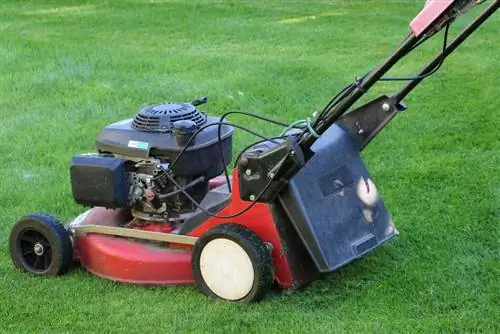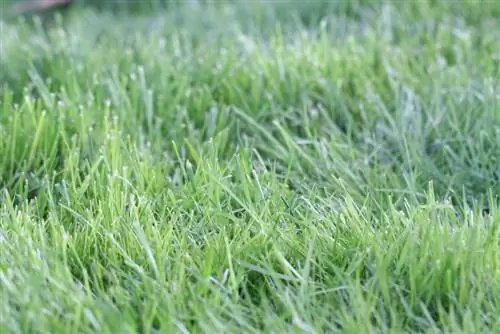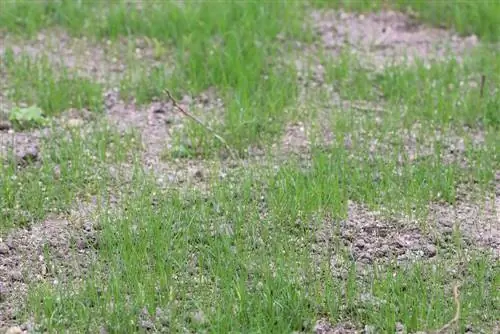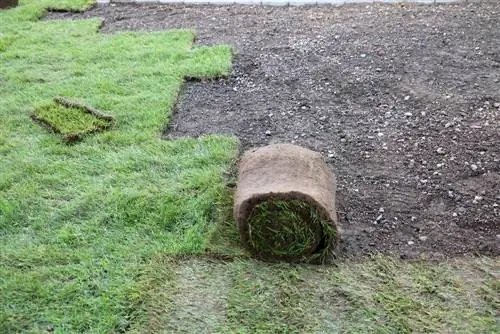- Author admin [email protected].
- Public 2023-12-17 03:39.
- Last modified 2025-06-01 06:48.
The lawn in front of the door should be evenly green, but should require almost no work. This actually works - but only if you are well informed right from the start about what a lawn needs to grow. You'll find out below, it's not much:
Sowing the lawn: creating a new lawn
Sowing a lawn is not difficult, get the right grass seed mixture for the location, spread the right amount on the prepared soil, water it, done. In order it looks like this:
Plan sowing, set time
Lawn seeds germinate when they are spread on the ground and given light, air and moisture - so lawns can theoretically be planted at any time between spring and autumn, even in winter when temperatures are a bit above zero.
However, there are reasons why new lawn installation is usually started in spring or autumn: lawn seeds need at least 14 days to germinate and during this time a soil temperature of over 10 °C. However, the sensitive seeds should not be exposed to excessive heat; even prolonged drought or heavy rain are not easy for young seeds to withstand. This means that summer is not the best time for sowing because seeds and young plants often have to contend with extreme weather conditions.
Spring weather is more suitable, it is not for nothing that nature has designed it so that plants begin to sprout in spring and go through their main growth phase in early summer. Spring is a good time for sowing, especially in areas with really cold winters, because the young plants can establish themselves firmly over the season until they are exposed to the winter cold for the first time.
Autumn is a better sowing time because the grass plants also distribute their seeds in nature during this time. In addition, temperatures now prevail where rain moistens the ground for longer and morning dew formation ensures even moisture in the ground. In addition, people have usually ended their gardening year with garden parties and the like, so the freshly sown lawn is hardly walked on anymore and can spend the winter calmly strengthening itself and strengthening itself until it is put under strain in the next season.
If you can choose the time, you should choose 1. autumn or 2. spring as the sowing time. If you are dependent on the work of others (construction companies, etc.), this is what matters: No matter when the last construction machine leaves, whether in July or February; if you want (e.g. B. to reduce “construction aggressions”), you can immediately start preparing the ground for the new lawn:
Soil preparation
For sowing, the future lawn must be provided with soil in which the seeds can germinate and then form longer roots. Whether you create this by putting the previously cleared topsoil back on the building site; digging up an old vegetable garden; Remove all possible foreign bodies from fallow land that has never been covered with plants, loosen the soil mechanically, enrich it with compost and let it "turn into soil" with green manure, it doesn't matter - the result should be at least 30 cm of good garden soil under the lawn that has the following characteristics has:
- between 5 and 20% humus
- loose crumb that allows water to pass through
- enough (organic) substance to support roots
- sufficiently solid substance to store moisture
- many soil organisms that will work the soil for you in the future
Of course, how much you have to do depends on the given condition of the soil. If the construction vehicles were just driving around, the soil has to be built up from scratch and you should start (including the relevant information work) long before the planned sowing. If you want to cover a piece of land in a well-kept natural garden with grass for a change, you probably don't have to do anything; all other variants lie somewhere in between. When the ground is prepared, it is straightened and the ground should settle for one to two weeks.
Tip:
Old lawn full of moss can be renovated, but only with laborious, time-consuming detailed work. In addition to the equally laborious alternative (milling off the old lawn, loosening the soil and preparing it for new sowing) or the not necessarily recommended quick-fix solution (milling off the old lawn and laying turf immediately), there has been an interesting new development since 2016: Schwab Rollrasen GmbH, one of the big ones In July 2016, ready-made turf producer, completed its long-term experiments with “rolled turf on old turf” and presented the sandwich construction as a result (information under schwab-rolled turf.de). It actually works, better than if the old lawn is removed first, at least with an old lawn as a base that still largely deserves the name.
Choose seeds
is logically the next step. It's better not to go to the nearest garden center for the most graphically appealing package, but to choose a standard seed mixture RSM or RSM Regio (information is available from the Forschungsgesellschaft Landschaftsentwicklung Landschaftsbau e. V., www.fll.de, which also puts together the grasses for the standard seed mixtures).
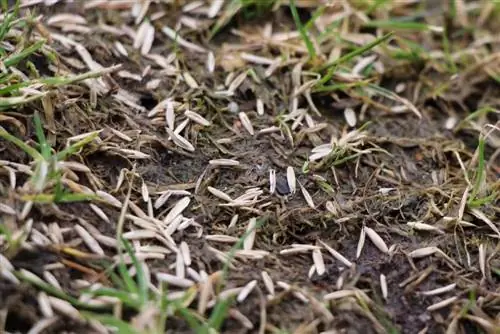
Selecting the seeds is probably the most important step for the long-term prosperity of the lawn. The independent experts who compile the standard seed mix mix 410 varieties of grass, bred from 10 different grass species with very specific objectives.
This results in seed mixtures that are very likely to do what they are supposed to do in their optimal locations: grow together into strong, even, lush green lawns. There are also companies that have great expertise and experience in putting together grass seeds; Schwab Rollrasen GmbH (schwab-rollrasen.de) has e.g. For example, among the 300 types of lawn they offer, they also include lawns made from self-composed lawn seed mixtures. But for starters, buying an RSM is a safe solution that you can't make a mistake with.
Tip:
RSM seed mixes are not the most expensive on offer; The often plain packs only cost a few euros per kilogram, which is enough for around 40 square meters. The packs of well-known brands in the garden center are more expensive; but not necessarily mixed according to RSM rules. It is not uncommon for robust feed mixtures to be included that have no place in lawn mixtures because they will “grow away” at some point.
Sowing
The selected lawn seed mixture can now be sown; the quantity per square meter is stated on the package. The seeds should be mixed thoroughly shortly before sowing, then the amount recommended for each seed (average: 25 grams per square meter) should be distributed as evenly as possible, which can also be done by hand. But the well-distributing seed throw requires concentration that should not be underestimated - if many square meters are to be covered with seeds, a spreader (available as a rental device) is a real help.
After spreading, the seeds should be raked in a little. On lawns that are cut at angles, this is sometimes only possible if you sow with the (lightweight children's) rake under your arm, because otherwise you would "trample" half of the seed when raking (trampling the seed is a step, even if you do so). 50 kg figure floats like a fairy across the lawn).
The light rake only needs to rake in the seeds lightly, because lawn seeds are light germinators and the raking is only intended to prevent the seeds from immediately dancing with the next gust of wind. Even hungry birds don't find raked seeds so quickly.
Tip:
During the breeding season, you can keep the feeding parent birds away from the lawn seeds with an unbeatable offer: Get a few packages of mealworms from the nearest pet store or from your friend with a terrarium; Protein-rich insects are exactly what parent birds instinctively look for as breeding food.
Reseeding the lawn - when & how?
You need this data especially if you re-sow at the recommended time in spring. Because here the grass plants should develop precisely where there are gaps in the lawn, so where the new grass plants have to fight against little competition. With this in mind, it is best to reseed in such a way that the seedlings can develop really well. They can do this if they are placed in the soil as soon as the temperatures allow grass plants to grow. In this way, they can “comfortably get through” some of the development stages in order to start vigorous growth even more quickly in warm temperatures. If the seeds are sown later in warmer weather, more germs germinate at the same time and then have to compete before they fill gaps in the lawn.
You can reseed at any time, as soon as the temperature in the soil is higher than 10 °C (for a few days, even at night). Reseeding in the spring fills the gaps a little more quickly, but on the other hand, if you always have a supply of lawn seeds in the house and use them constantly, the gaps will not be so large that speed is important when closing them. Then you sow immediately whenever a fungus has eaten a few lawn plants, the dog had to dig in the middle of the lawn, the football party left a few holes, etc. This continuous reseeding hardly requires any work and constantly renews the lawn, which is only good for the uniformity of the green area.
Mowing freshly sown lawn
Every sowing of grass plants initially produces “only grass plants”. These grass plants only become lawns when they are forced by constant cutting to develop evenly in the upper area with branching and to form a dense, interwoven turf in the root area.

Therefore:
The more often you mow and the less you cut off with each mowing, the more beautiful, even and stronger the lawn becomes. Gardeners who maintain good quality English lawns or later harvest turf mow them every day or every other day during the main growing season, depending on the variety. You don't have to do it, but young, tender grass plants should see/feel a lawnmower once a week and young, strong grass plants should see/feel a lawnmower twice a week.
Freshly sown lawns are mown as early as possible, even if the delicate plants still look very delicate. Immediately after sowing, the stalks are allowed to grow to a height of 10 cm and are then cut to approx. 5 cm; Afterwards, it is best to mow the lawn when it has just gained 2.3 cm.
If you “weigh a few kilos”, the trick is not to damage the young lawn with the load when mowing; When planting new lawns and reseeding larger amounts, it is worth looking for a tender child who can and can operate the lawnmower. In addition, especially with freshly sown lawns, it is important to make sure that the lawn mower blades are really sharp, i.e. cut and not pluck. Regrinding is usually offered as a service in garden centers or hardware stores.
Fertilize freshly sown lawn
If you have chosen natural, organic fertilization, you will have applied enough compost when preparing the soil in autumn to feed the lawn in spring. The sowing first feeds itself on the “provisions” that each seed has with it, until the first roots access the nutrients that hard-working soil organisms have broken down over the winter so that they are available to plants. Once the first roots have “munched” for a while, you will notice whether you have provided the soil adequately during preparation. If the soil has been treated like a soil for a long time, i.e. has not been damaged or impoverished by synthetic fertilizers or poisons from pesticides, and has not had to feed hungry heavy eaters for years in front of the lawn, there should be no problems.
Lawns don't actually need a lot of fertilizer, and they will extend their roots deeper into the soil if they are fed moderately. This “reaching the roots deeper into the ground” is more than desirable - this is called sod, the heart of a real lawn, cared for by real lawn gardeners almost like a little sanctuary.
In spring, the organically fertilized, freshly sown lawn gets a small appetizer, which is put together depending on its appearance: If it grows nice and green and everything is in order, e.g. B. a little nettle manure, which fertilizes and prevents the excessive spread of all kinds of diseases and pests. If the young lawn has been watered too diligently (which often happens with good intentions) and a few fungi have grown as a result, rock dust is first scattered, then fungicidal plant manure made from horsetail, liverwort or garlic, mustard or horseradish leaves is sprayed. If he just looks like he could use a little pick-me-up, give him a few liters of organic liquid fertilizer (made from mature compost or bought ready-made).
In autumn, organically fertilized lawns receive their main fertilization from compost. During the season, this compost is fed with all household waste that turns into soil: all food (cleaning) leftovers (except for meat and sausage trimmings and prepared food), animal litter and houseplant trimmings, coffee grounds and leached tea herbs. Garden waste, tree and shrub cuttings and leaves come from the garden; If all of this is not enough, some purchased organic fertilizer is mixed in. Commercially available organic fertilizer for lawns needs, above all, a fine structure so that it can quickly reach the soil organisms through the dense lawn roots; Otherwise it doesn't matter whether it is specially finely adjusted "organic lawn fertilizer" or horn meal, guano, dried, chopped horse manure.
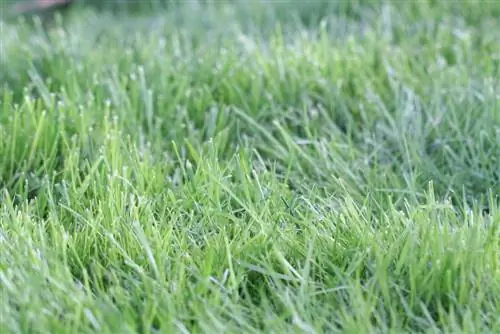
In autumn, the pH value is also briefly determined in order to give the lawn some lime if necessary, and before winter it looks forward to an extra portion of potassium so that the newly formed plant cells that are formed during the season can mature well (manure, comfrey broth, wood ash, coffee grounds, banana peels, rose hips, elderberry contain a particularly high amount of potassium).
If the lawn is to be fertilized with synthetic fertilizers based on mineral oil, this will be calculated and administered based on soil analysis. For larger contiguous areas, reseeding is treated like newly sown lawn and is otherwise included in the general fertilization routine of the lawn.

